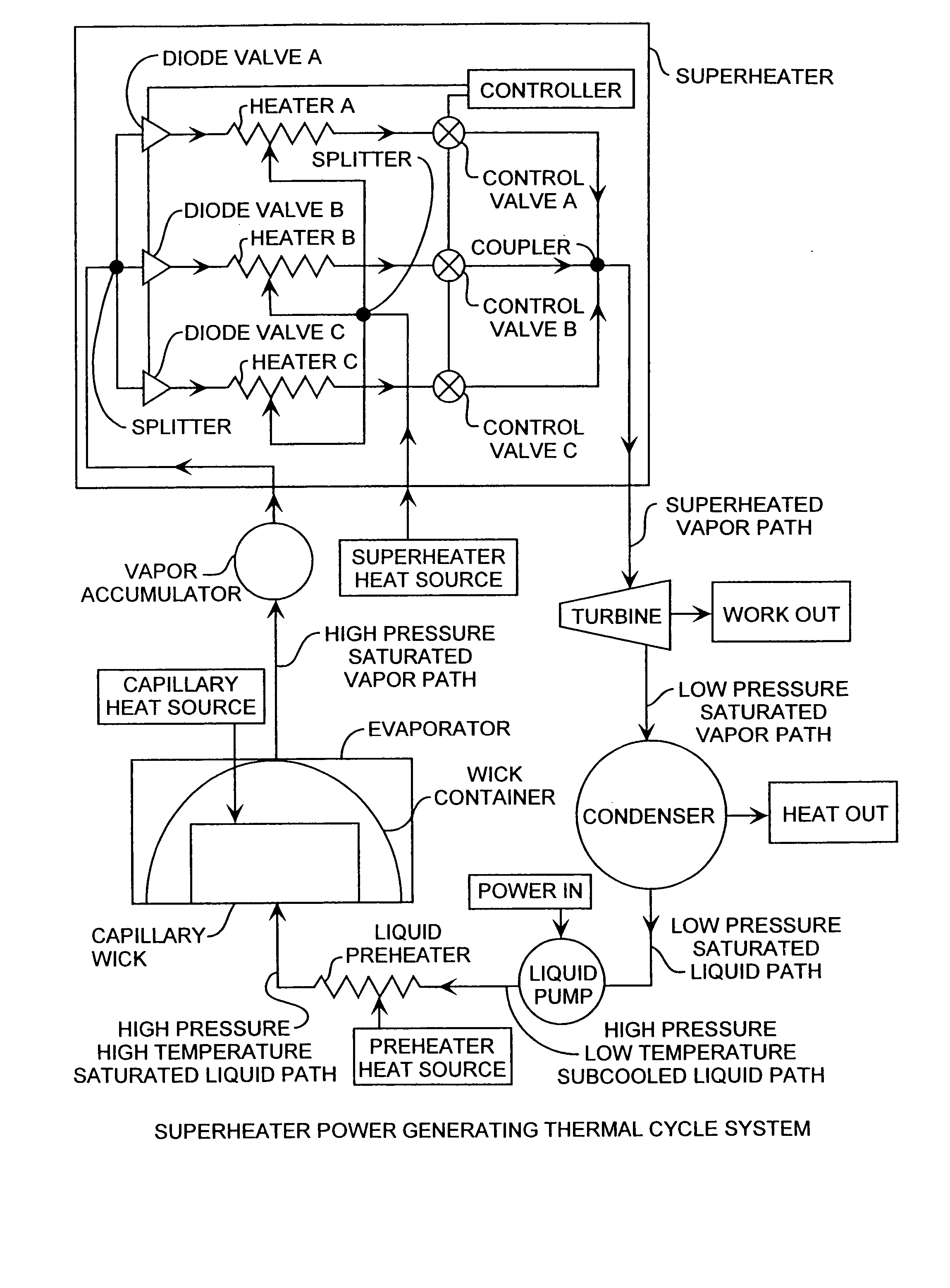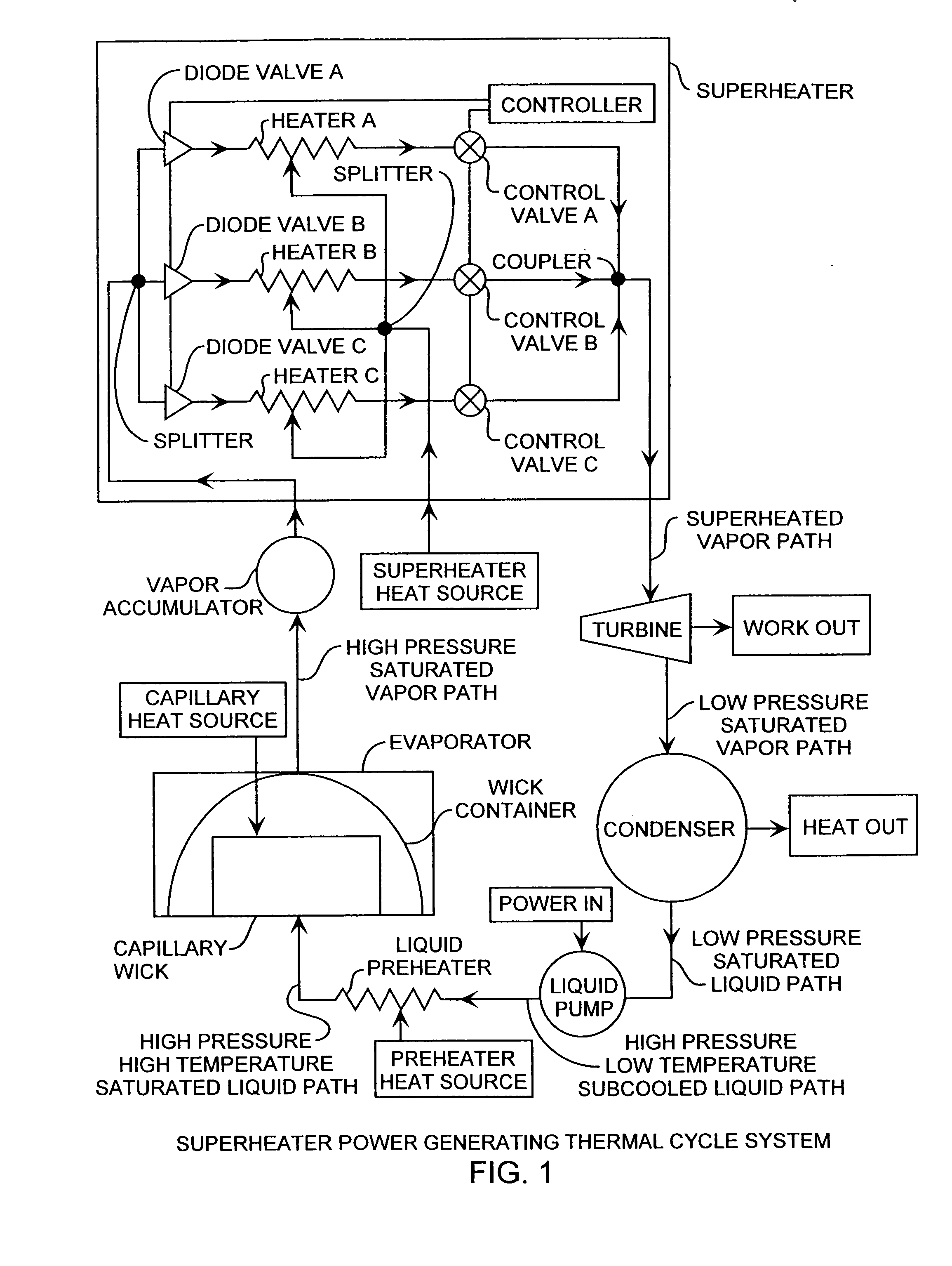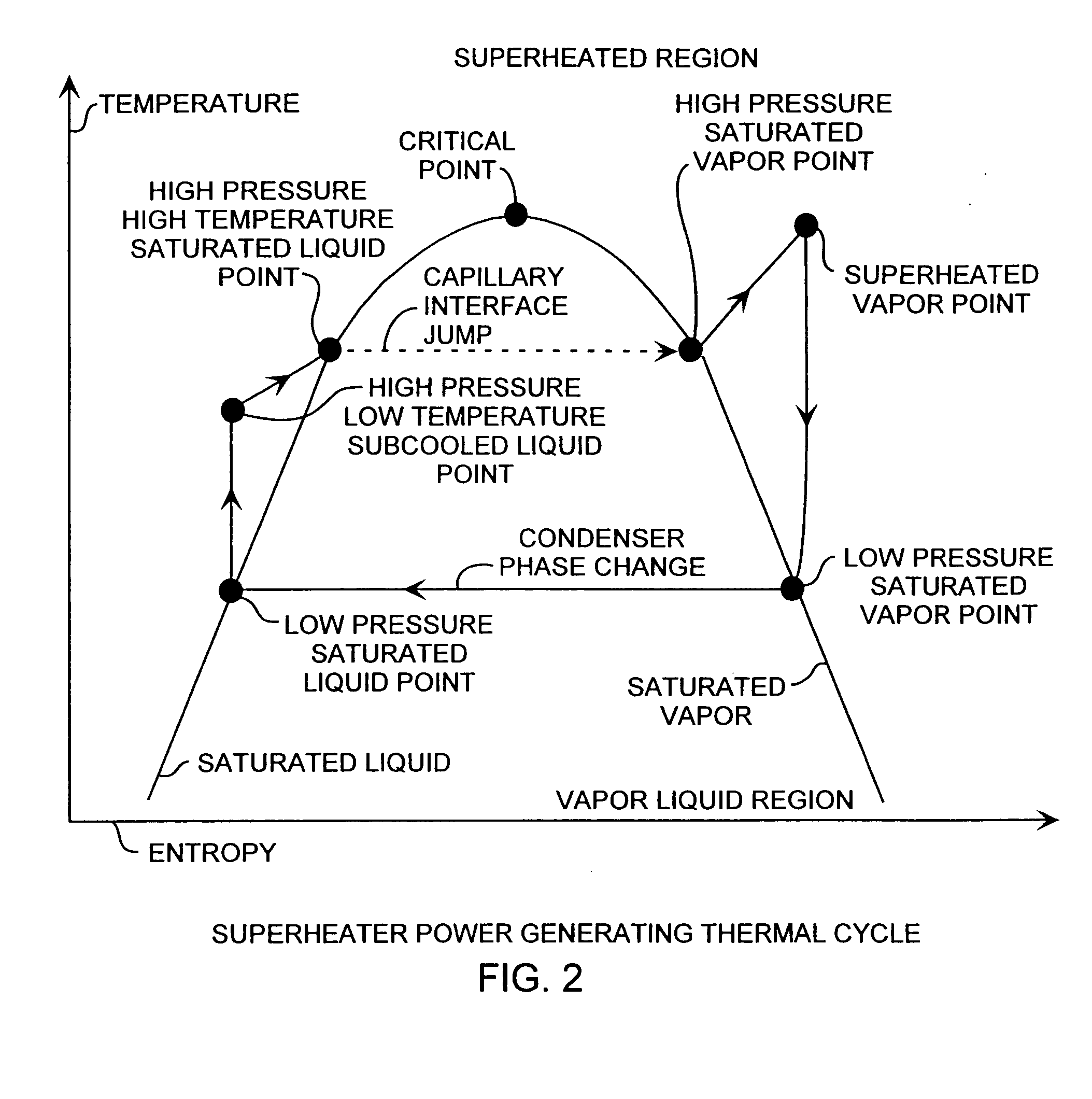[0014] Yet, another object of the invention is to provide a two-phase
thermal cycle for use in a thermodynamic power system pressurized by a capillary device, superheater and liquid pump for generating power at high efficiencies while operating at low temperatures.
[0022] Still a further object of the invention is to provide a two-phase
thermal cycle for use in a thermodynamic power system pressurized by a capillary device for generating power during power generation with improved efficiency using an in-line superheater, a preheater, and a liquid pump.
[0023] The system is directed to a two-phase thermodynamic power cycle system that converts
heat energy to work particularly useful in
space power systems. The system uses a capillary wick of a capillary device that uses input heat to generate high-pressure saturated vapor. The high-pressure saturated vapor is kept separate from low-pressure saturated liquid. This capillary wick facilitates the flow transition from
high pressure, high temperature, saturated liquid to high-pressure, saturated vapor, instantaneously, providing effective separation between liquid and vapor and being a passive pump. The system solves the problem of two-phase
fluid management in
micro gravity by simplifying the two-phase
thermodynamic cycle system using a capillary device, such as
loop heat pipe or a capillary pumped loop, for two-phase
fluid control. The system is a power conversion unit that receives heat from a heat source to passively drive the
capillary action. The
capillary action passively separates liquid from vapor and pressurizes the flow so that high-pressure saturated vapor can enter the superheater of the system. Saturated high-pressure vapor flows into the superheater through
diode valves. These valves allow the flow to enter the superheater but prevent the flow from flowing back towards the
evaporator. Once the pressure in the superheater equals the pressure of the
high pressure, saturated vapor, flow into the superheater stops. Heat addition to the high-pressure, saturated vapor continues until the vapor reaches the desired superheated vapor state. Once the vapor reached the desired state of superheat, the superheater control valve is opened releasing superheated vapor that flows to the turbine. Vapor flows isentropically through the turbine where work is taken out of the flow. Multiple superheater stages can be used. The pulsing of these
multiple stages can be staggered in order to obtain a flow that is steadier than simple pulses. The superheater can be one leg or several parallel tube legs, for example each leg tens of feet long, bent in a serpentine manner, attached to a heat source. Each leg of the superheater has a controllable
diode input valve and controllable exit valve. The flow exits the turbine as low-pressure, saturated vapor and enters the condenser. The vapor condenses in the condenser and leaves as low pressure saturated liquid. The condenser can be one tube, for example, tens of feet long, bent in a serpentine manner, and attached to a condenser panel. The condenser tubing can also be fabricated in a conventional
parallel arrangement. Liquid enters a pump where work is put in and the liquid is pressurized isentropically to a
high pressure, low temperature, subcooled liquid. The high pressure, low temperature, subcooled liquid flows through the liquid preheater and leaves as a high pressure, high temperature, saturated liquid which enters the
evaporator to repeat the cycle. The liquid preheater can be one tube, for example, tens of feet long, bent in a serpentine manner, and attached to a heat source. The preheater tubing can also be fabricated in a conventional
parallel arrangement.
[0024] The system preferably includes an evaporator comprising a capillary device having a capillary wick for receiving input heat and providing a
phase change, a vapor accumulator to dampen and prevent
mass flow oscillations from effecting the operation of the evaporator, a superheater receiving input heat and providing further increased pressure and temperature to the high pressure saturated vapor, a turbine for providing power, a condenser for radiating heat, a liquid pump for increasing the pressure of the low pressure saturated liquid and a preheater for increasing the temperature of the high pressure, low temperature, subcooled liquid.
[0026] The system preferably uses
spacecraft thermal control technology, including loop heat pipes and capillary pumped loops, by combining these capillary devices with a turbine, superheater, liquid pump and liquid preheater. Loop heat pipes and capillary pumped loops are used for
thermal control applications on
spacecraft for a variety of reasons including that these devices allow for
system integration with flexible lines, and enable deployable condensers. The system provides a two-phase dynamic power system suitable for space application. The system can be cost efficiently built as a system to generate power using the
waste heat as a portion or all of the input heat from a spacecraft or waste heat from another dynamic or static power
converters in a cascaded manner. This waste heat or cascaded system will yield a
space power system with an
overall efficiency of well over thirty percent to provide a spacecraft with significantly more power while enabling
ion propulsion and increased
payload capabilities.
[0028] The superheater is used to significantly increase the pressure of the vapor by adding additional heat bringing it to a superheated state. Although the vapor flow from the evaporator flows through the accumulator into the superheater, the evaporator is not exposed to the high pressures generated in the superheater. This is accomplished by pulsing the superheater using controllable
diode and
control valves. This allows for significantly higher-pressure, superheated vapor to flow into the turbine for power generation. This also insures that the
working fluid flowing into the turbine is all vapor. In the preferred form of the invention, the superheater, disposed after the capillary wick and accumulator, is connected to a higher temperature heat source compared to the evaporator and liquid preheater heat sources. The superheater used in combination with a preheater and with a liquid pump that are both disposed before and the capillary wick allow for improved efficiency by increasing the operating range of the system. The flow is high-pressure saturated vapor that flows into the superheater. The superheater is preferably a
heat exchanger that must interface with a heat source that is maintained at a higher temperature than the capillary wick. In practice, the superheater is a plurality of heat exchanging tubular chambers through which the cycle working fluid flows and is heated. Flow at the entrance to these chambers is checked by a diode valve, only allowing flow in. The exit to these chambers is checked by a control valve, operated so that the chamber pulses. This heat chamber can be attached to an external heat source. The flow is then heated for staggered release. Using multiple chambers, a quasi-continuous superheated vapor flow can be achieved for driving the turbine. The superheater is used to increase the efficiency of the cycle and to heat the working fluid to ensure that no condensed droplets enter the turbine. The impingement of droplets on the turbine will eventually cause the turbine to erode. The superheated vapor is passed through the turbine.
Thermal energy storage material such as a
phase change material can be connected to the superheater to store energy so that the superheater can operate constantly even if the heat source is not steady such as solar heating in
Low Earth Orbit. This
thermal energy storage material can be a
single phase metal such as
beryllium, or a two phase such as
lithium or a
molten salt that changes phase at the superheater
operating temperature.
 Login to View More
Login to View More  Login to View More
Login to View More 


